|
The Gooseneck
This page was last updated on July 10, 2004.
|
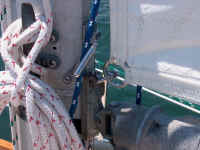 My
original mast was equipped with a sliding gooseneck. This
consisted of a slim aluminum T-track bolted to the aft side of the mast
with several stainless steel screws, and was designed to accept a bronze
car attached to the end of the boom. With a sliding gooseneck, the
boom could be pulled down to help tension the mainsail luff--a workable,
but antiquated, system. When I bought the boat in 1999, the
hardware was already 37 years old. My
original mast was equipped with a sliding gooseneck. This
consisted of a slim aluminum T-track bolted to the aft side of the mast
with several stainless steel screws, and was designed to accept a bronze
car attached to the end of the boom. With a sliding gooseneck, the
boom could be pulled down to help tension the mainsail luff--a workable,
but antiquated, system. When I bought the boat in 1999, the
hardware was already 37 years old.
Looking back, I'm sure the original setup
was destined for failure under my watch. Why? Well, one
important rigging upgrade I made immediately upon launch in 2001,
following my complete restoration of the boat, was to install a
spring-loaded rigid
boom vang from Garhauer Marine. Installing the boom vang, by
nature, required fixing the gooseneck in place to prevent sliding.
With a stop bolt and some line, I secured the boom so that it couldn't
slide up or down, or at least not much. It worked well enough, and
I postponed any thoughts of locating a new, fixed gooseneck fitting for
the mast, though I had the thought at the time. There was so much
going on at the time, shortly after my initial launch, and I was focused
on trial sailing, so any further attention to the gooseneck went by the
wayside.
|
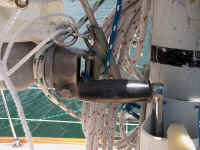 Early
in the 2002 season, the original aluminum gooseneck track failed,
breaking right at one of the screw locations. The breakage was
caused by several factors, including age and weakness caused by
corrosion between the track and the stainless steel screws securing it
to the mast. The new vang also had increased the
pressure on the fitting, as in pulling down the boom, the vang also
tended (they all do) to pull the boom itself forward, into the
track. Particularly off the wind, this caused side loading to the
track, and all of this was simply too much for the tired materials. Early
in the 2002 season, the original aluminum gooseneck track failed,
breaking right at one of the screw locations. The breakage was
caused by several factors, including age and weakness caused by
corrosion between the track and the stainless steel screws securing it
to the mast. The new vang also had increased the
pressure on the fitting, as in pulling down the boom, the vang also
tended (they all do) to pull the boom itself forward, into the
track. Particularly off the wind, this caused side loading to the
track, and all of this was simply too much for the tired materials.
|
 I
temporarily repaired the track at the time by removing an extra section
of the track from the mast and installing it in place of the broken
section with new screws that I tapped into the mast. However, it
was clear that the old aluminum track had simply run its course, for a
few weeks later, during the first day of a 2-month cruise, the gooseneck
failed once more, breaking the track again. I
temporarily repaired the track at the time by removing an extra section
of the track from the mast and installing it in place of the broken
section with new screws that I tapped into the mast. However, it
was clear that the old aluminum track had simply run its course, for a
few weeks later, during the first day of a 2-month cruise, the gooseneck
failed once more, breaking the track again.
We survived with the gooseneck lashed
to the mast for a week or two before I had a chance to address a
more permanent repair. The materials I had on board included some
new 1" aluminum T-track, which I had tried using earlier for the
repair, but found that the old bronze car on the boom required a
7/8" track section. However, now it was time to make do, so
with a hacksaw I carefully removed 1/8" of the track in a
longitudinal direction, which allowed the car to fit well. Then, I
secured the new track to the mast with new fasteners tapped into 1/4-20
holes. The new arrangement seemed very secure, and served well for
the remainder of the cruise, and in fact through the remainder of the
2002 season and all of 2003. It worked so well, seemingly, that I
put its replacement at the bottom of a large, and ever-present, list of
boat projects, upgrades, and maintenance.
|
|
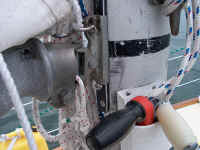
|
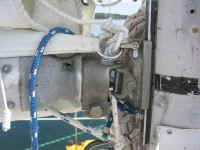 The
2004 season began uneventfully, but on a day in early June, I
noticed--while working on a nearby project--that the once-successful
gooseneck repair had begun to fail again. The entire track was
pulling slightly away from the mast, leaving a gap of about
1/8". The forces from a hairy gybe a day or two earlier may
have caused the issue, or maybe not; I wasn't sure. In any event,
the screws seemed to have lost their grip on the spar. Abandoning
the other project I was working on, I addressed the track by tightening
the screws--they seemed to hold OK--and installing one new screw
directly behind the boom car location. This seemed to hold, but
after sailing that day I noticed that the track had once more pulled
away. Obviously, more drastic measures were going to be
necessary. It was time to track down and install a real mast
gooseneck fitting--one that was fixed in place and up to the challenges
imposed by the boom and boom vang pressures. The
2004 season began uneventfully, but on a day in early June, I
noticed--while working on a nearby project--that the once-successful
gooseneck repair had begun to fail again. The entire track was
pulling slightly away from the mast, leaving a gap of about
1/8". The forces from a hairy gybe a day or two earlier may
have caused the issue, or maybe not; I wasn't sure. In any event,
the screws seemed to have lost their grip on the spar. Abandoning
the other project I was working on, I addressed the track by tightening
the screws--they seemed to hold OK--and installing one new screw
directly behind the boom car location. This seemed to hold, but
after sailing that day I noticed that the track had once more pulled
away. Obviously, more drastic measures were going to be
necessary. It was time to track down and install a real mast
gooseneck fitting--one that was fixed in place and up to the challenges
imposed by the boom and boom vang pressures.
|
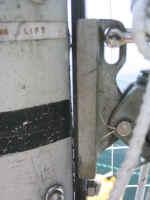 In
the meantime, however, I needed another "temporary" fix so
that I could keep sailing while tracking down a new mast fitting.
The mast already looked like Swiss cheese behind the track, with myriad
holes from the old track, the first attempt at repair, and the more
successful later repair. I didn't relish drilling even more holes
in the spar. In
the meantime, however, I needed another "temporary" fix so
that I could keep sailing while tracking down a new mast fitting.
The mast already looked like Swiss cheese behind the track, with myriad
holes from the old track, the first attempt at repair, and the more
successful later repair. I didn't relish drilling even more holes
in the spar.
|
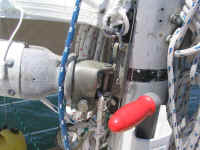
In Depth:
The Gooseneck Forces
By nature, the boom-end fitting and
arrangement forces awkward pressures on the track system when the boom
is let out while sailing downwind. As the boom is swung out, the
pressure changes from a direct fore and aft force to one that pushes or
pulls in a more sideways direction--a direction that these sorts of
tracks and fasteners are not designed to support.
The problem
is exacerbated--perhaps dooming the arrangement to failure--by the
installation of a solid boom vang, which puts higher pressures on the
fittings than the original setup might have. Tensioning the
vang not only pulls the boom down; it also pulls the boom towards
the mast. With the boom let out (and the time when the vang is
most important), this translates to increased sideways pressure on the
track and track fasteners on the mast. Did this cause the failure
of the threads in the mast? Was it one-time shock loads from a
difficult gybe? Is the aluminum mast simply losing its strength
after more than 40 years of service? Or was it a combination of
all these factors?
|
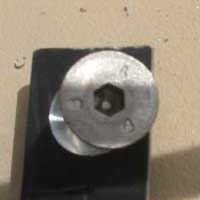 Instead,
I decided the best course of action would be to replace the 1/4-20
fasteners with the next size up. I hoped that retapping the
threaded holes in the mast with a larger size would allow the new
fasteners to grip sound material and hold, without forcing the need for
additional holes in the mast. At the hardware store, I found that
the only 5/16" stainless steel flathead fasteners they had featured
a hex drive (Allen wrench), but that was fine. Instead,
I decided the best course of action would be to replace the 1/4-20
fasteners with the next size up. I hoped that retapping the
threaded holes in the mast with a larger size would allow the new
fasteners to grip sound material and hold, without forcing the need for
additional holes in the mast. At the hardware store, I found that
the only 5/16" stainless steel flathead fasteners they had featured
a hex drive (Allen wrench), but that was fine.
|
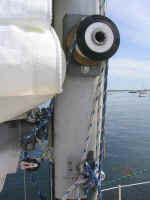 The
flat heads were important, since the track car needed the clearance to
pass over their tops. I purchased a number these fasteners, as
well as a single 5/16-24 hex head bolt, which I planned to use beneath
the boom slide to prevent it from falling too low; previously, I had
used a pan head screw with a larger bolt behind the head to hold it out
further and therefore hold the slide in place, but I could find no such
fasteners in the larger size, so I chose the hex bolt. The
flathead fasteners I picked up had a coarse, thread (5/16-18), so I made
a mental note to be careful when tapping the holes later and
ensure that I used the proper tap in the proper hole. The
flat heads were important, since the track car needed the clearance to
pass over their tops. I purchased a number these fasteners, as
well as a single 5/16-24 hex head bolt, which I planned to use beneath
the boom slide to prevent it from falling too low; previously, I had
used a pan head screw with a larger bolt behind the head to hold it out
further and therefore hold the slide in place, but I could find no such
fasteners in the larger size, so I chose the hex bolt. The
flathead fasteners I picked up had a coarse, thread (5/16-18), so I made
a mental note to be careful when tapping the holes later and
ensure that I used the proper tap in the proper hole.
Out at the boat, I began by lifting the
boom off the track and securing it out of the way to provide clear
access to the area. I held it up with a line wrapped over the main
halyard winch, and pulled the car over to one side with another line to
hold it securely.
|
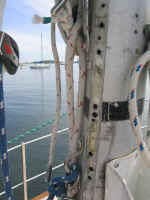 With
the boom out of the way, I removed the track and old fasteners, and
marveled at the horrible appearance of the mast beneath, peppered with
holes. Oh well: most of the holes had been there since the
mast was first built, and the rest had been there for two years. I
checked the area carefully for more serious signs of stress, however; I
saw no evidence of cracking or other signs of more major trauma, and
proceeded as planned by tapping three of the four holes for the track
with a 5/16-18 tap, and the final hole--carefully marked by me--with the
finer 5/16-24 tap for the hex head bolt. I hoped that the new
threads would hold in stronger material; the old threads had failed in
the mast material, leaving bits of aluminum in the fasteners that I
removed. Apparently, the force had simply sheared the threads,
pulling them right of the mast. I became a little wary of the
overall strength of the mast aluminum, but pressed onwards for now. With
the boom out of the way, I removed the track and old fasteners, and
marveled at the horrible appearance of the mast beneath, peppered with
holes. Oh well: most of the holes had been there since the
mast was first built, and the rest had been there for two years. I
checked the area carefully for more serious signs of stress, however; I
saw no evidence of cracking or other signs of more major trauma, and
proceeded as planned by tapping three of the four holes for the track
with a 5/16-18 tap, and the final hole--carefully marked by me--with the
finer 5/16-24 tap for the hex head bolt. I hoped that the new
threads would hold in stronger material; the old threads had failed in
the mast material, leaving bits of aluminum in the fasteners that I
removed. Apparently, the force had simply sheared the threads,
pulling them right of the mast. I became a little wary of the
overall strength of the mast aluminum, but pressed onwards for now.
|
|
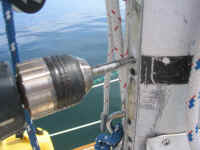
|
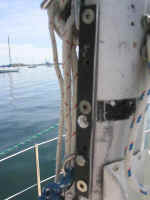 I
reamed out the 1/4" holes in the track with a 5/16" bit to
accept the new fasteners, and increased the size of the countersinks for
the larger heads. I was happy to be dealing with aluminum, which
milled easily. I tapped the entire length of the hole where the
boom-supporting hex head bolt would go, however, to give the threads
increased biting area. Then, I reinstalled the track, tightening
all fasteners securely. I
reamed out the 1/4" holes in the track with a 5/16" bit to
accept the new fasteners, and increased the size of the countersinks for
the larger heads. I was happy to be dealing with aluminum, which
milled easily. I tapped the entire length of the hole where the
boom-supporting hex head bolt would go, however, to give the threads
increased biting area. Then, I reinstalled the track, tightening
all fasteners securely.
With that, the repair project was
complete for the moment. A light air sail shortly thereafter
caused no concern about the gooseneck, but served as a decent trial
nonetheless. All this happened on a weekend, but I planned to
begin a serious search for a mast gooseneck fitting to accept my boom
end as soon as the workweek began. No resting on my laurels this
time: it was time, once and for all, to replace this
tried-and-true, but seriously weakened and completely unacceptable,
arrangement.
|
|
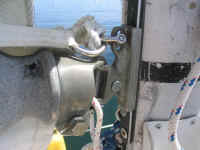
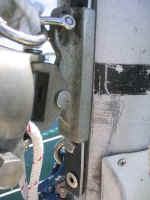
|
Please click here
to continue the project.>
|
|